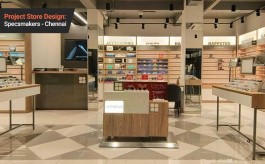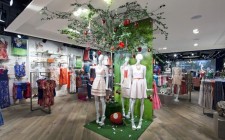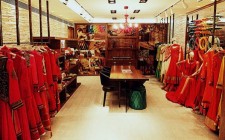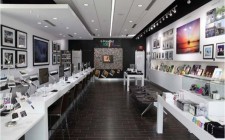Jhaal Farezi: Fine dining with a dash of nostalgia
By Nabamita Chatterjee | Vjmedia Works | August 03, 2013
Frozen relics from the past combined with retro Indian pop art make this restaurant an experience that is both spatial and culinary in a uniquely charming way...
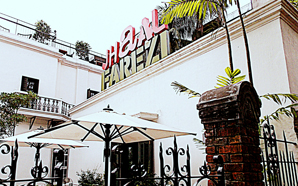 Jhaal Farezi, the new dine den at 42 Circus Avenue, Kolkata, launched by Ambuja Neotia Group, is all about reviving the colonial charm of a city in the midst of changing skylines. The 80 year old British bungalow has been converted into a period piece of fine dining warren infused with contemporary visuals and offering a holistic ambience to the food lovers. High ceilings, giant columns, latticed windows, conical verandahs with iron balustrades and an exquisite porch, all add towards evoking nostalgia at one glance.
Jhaal Farezi, the new dine den at 42 Circus Avenue, Kolkata, launched by Ambuja Neotia Group, is all about reviving the colonial charm of a city in the midst of changing skylines. The 80 year old British bungalow has been converted into a period piece of fine dining warren infused with contemporary visuals and offering a holistic ambience to the food lovers. High ceilings, giant columns, latticed windows, conical verandahs with iron balustrades and an exquisite porch, all add towards evoking nostalgia at one glance. Located centrally right at the heart of the city, Jhaal Farezi is a spatial experience for all. "For me, Jhaal Farezi has been somewhat of an exploration, giving me the opportunity to interpret eclectic impressions and sensibilities that have stayed in my mind over time,†shares, Harshavardhan Neotia, Chairman, Ambuja Neotia who parented the project. Catering to a city, which is a melting pot of various cultures, the restaurant offers a mixed fare, with Anglo Indian food being the highlight. Hence the name Jhaal Farezi, a typical Anglo Indian dish from yesteryears.
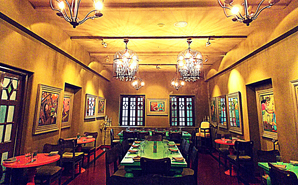 Spread over an area of approximately 10,000 sq.ft., Jhaal Farezi houses a Café, a fine dining area (both mutually exclusive), a music room and the Alfresco terrace garden with a sit-out. Channa Daswatte, Architect, Jhaal Farezi, said - "For me, the entire experience of recreating an old battered bungalow into a palatable contemporary counterpart keeping its soul intact was a challenge. The driving force was to preserve the old world charm, yet turn it around and make it relevant and sustainable. The overall look and feel continues to be colonial. Hopefully, Jhaal Farezi will be as much a spatial as a culinary experience for the City of Joy!â€
Spread over an area of approximately 10,000 sq.ft., Jhaal Farezi houses a Café, a fine dining area (both mutually exclusive), a music room and the Alfresco terrace garden with a sit-out. Channa Daswatte, Architect, Jhaal Farezi, said - "For me, the entire experience of recreating an old battered bungalow into a palatable contemporary counterpart keeping its soul intact was a challenge. The driving force was to preserve the old world charm, yet turn it around and make it relevant and sustainable. The overall look and feel continues to be colonial. Hopefully, Jhaal Farezi will be as much a spatial as a culinary experience for the City of Joy!â€The interior décor of Jhaal Farezi has myriad shades, it is eclectic, versatile and ranges from rustic brash to Bollywood melodrama. Swarup Dutta - Visualiser & Interior designer of Jhaal Farezi shares, "The project gave a lot of scope to innovate and transform every aspect of it into an experiential zone. Both the Cafe rooms have a different theme, one has a formal style and the other a casual one, yet they are cohesive. We have created a lot of interesting wall arts like the salacious Bhojpuri songs graphically shown by street art of old Calcutta which is Kalighat's'Pattachitra'. Another art form which is a great visual treat to all eyes is the "fine appliqué work†sourced from Barmer in Rajasthan framed for the walls, screaming Bollywood dialogues add hues to the whole decor.â€
 The props have been placed as'frozen relics from the past' as described by Swarup and the wall art especially in the Cafe depicts it uniquely. Inspired by the industrial past, there are elements that are iconic of a distant past: barber chairs and revived enamel plates echoing'casual conversation'. The lighting arrangements in the Cafe lend a new dimension with a chandelier made from old glass jars of Horlicks, jam,'achar' and such, which enhances the vintage look and feel.
The props have been placed as'frozen relics from the past' as described by Swarup and the wall art especially in the Cafe depicts it uniquely. Inspired by the industrial past, there are elements that are iconic of a distant past: barber chairs and revived enamel plates echoing'casual conversation'. The lighting arrangements in the Cafe lend a new dimension with a chandelier made from old glass jars of Horlicks, jam,'achar' and such, which enhances the vintage look and feel."The whole idea is to celebrate Indi-chic. We are catering to the urban'glocal' clientele. The space thus provides a glimpse of a vibrant Indian pop culture, which is increasingly becoming the new visual language. Graphic art has been predominantly used to establish this connection. It is an easygoing non- stressful celebratory language of the urban Indian,†said Swarup. Thus to break the monotony of white, a dramatic installation welcomes as one takes the main staircase for the dining rooms in level two, which has an artwork of neon letters on multi-coloured wooden plates which echo Ghalib's'Hazaaron Khwaishein Aisi ki har khwaish pe dam nikle.'
The fine dining area has been divided into five rooms and each, again, highlights various thematic expressions.The first level has formal colonial design chairs juxtaposed against modern minimal design furniture with the walls having an illustrated comic strip narrating the story of a Bengali guy called Mr. Mazoomdar, created by graphic artist Orijit Sen. The green colour from the pictures spills onto the tables, building a'land of fantasy and traditional folk lore'.
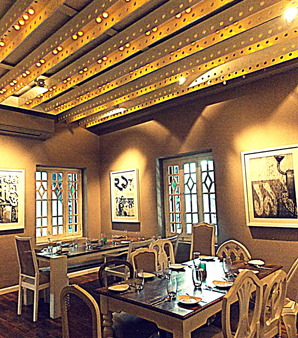 The adjoining room again is lit up by a majestic installation of 1,700 wine bottles that the team of Jhaal Farezi hunted down. "We broke around 100 and had to drink and empty around eight to create the feel of'eclectic India', shares Swarup. Not to be left behind, the chairs too have embroidered Murshidabad geometric kantha upholstery on them, depicting the intricate hand work of Bengal as well as breaking the code of formal dining room. In the Drama Queen room, the third section in the same level, where one may host a small private party, also offers a fun filled decor in colourful appliqué work, expressing dramatic dialogues from Hindi movies like'Main tumhare bachhe ki ma banne wali hoon''aaaree rere' and many more typical'filmi' quotes. Another room on this level has photographs of torn posters and monochrome graffiti, reflecting the city walls and establishing a true connect with the sentiments of the'City of Joy.' The false ceiling created with iron bars which are lit up with small yellow lights gives a harmonious balance of warm wood with cold metal in the room, matching the set up of industrial minimalism at the fine dining level. Thus the experiential design in Jhaal Farezi is truly artistic, antique and iconic.
The adjoining room again is lit up by a majestic installation of 1,700 wine bottles that the team of Jhaal Farezi hunted down. "We broke around 100 and had to drink and empty around eight to create the feel of'eclectic India', shares Swarup. Not to be left behind, the chairs too have embroidered Murshidabad geometric kantha upholstery on them, depicting the intricate hand work of Bengal as well as breaking the code of formal dining room. In the Drama Queen room, the third section in the same level, where one may host a small private party, also offers a fun filled decor in colourful appliqué work, expressing dramatic dialogues from Hindi movies like'Main tumhare bachhe ki ma banne wali hoon''aaaree rere' and many more typical'filmi' quotes. Another room on this level has photographs of torn posters and monochrome graffiti, reflecting the city walls and establishing a true connect with the sentiments of the'City of Joy.' The false ceiling created with iron bars which are lit up with small yellow lights gives a harmonious balance of warm wood with cold metal in the room, matching the set up of industrial minimalism at the fine dining level. Thus the experiential design in Jhaal Farezi is truly artistic, antique and iconic. "Jhaal Farezi is a special tribute to the city of joy at multiple levels: spatial, architectural, cityscape and culinary,†signs off Harshavardhan Neotia, Chairman, Ambuja Neotia.
Photographs - Madhumita Chatterjee
Advertisement

